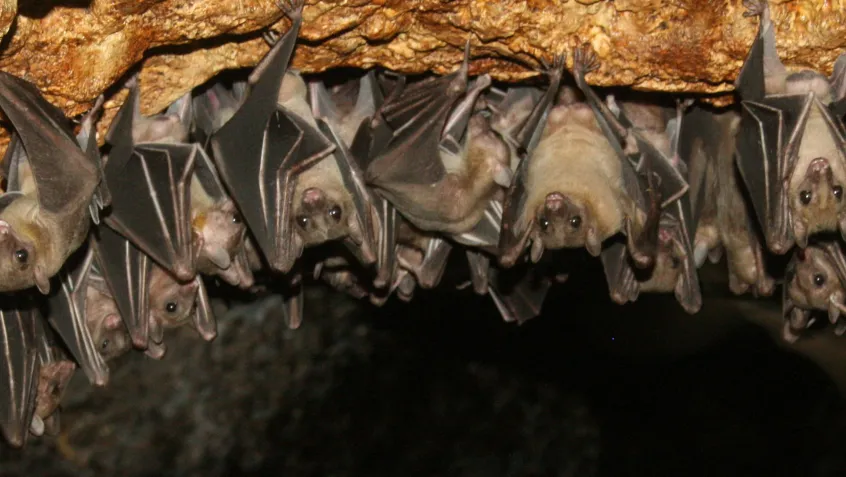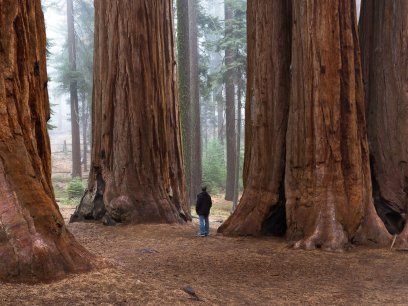
For better or worse, bats are one of the definitive symbols of Halloween.
One of the reasons these little flying mammals have become synonymous with the holiday may be that some bat species fly south for the winter, making them easier to spot throughout the spooky season. But their association with Halloween’s creepy crawlies has given bats a bad rap.
These amazing—yet often misunderstood—creatures play an important role in ecosystems around the world, year-round. But today, bat populations are in decline due to loss of habitat and disease, putting those ecosystems at risk. Of the 43 bat species that live in the US and Canada, nearly 40% are endangered.

Celebrate Bat Conservation During Bat Week
Bat Week is celebrated from October 24-31 each year to raise awareness about bat conservation. Bats eat insects, pollinate hundreds of types of plants, and spread seeds that grow into our forests and deserts. Because bats know no boundaries, they provide ecological benefits far beyond their home base.
Despite their contributions, bats and bat habitats have not always been protected. Early on, caves and abandoned mines on public lands were considered hazards and were often sealed to protect visitors, trapping bats inside and closing off important bat habitats. Lighting added to some caves to improve visibility for visitors also disrupted nesting bat colonies.
Bats on Public Lands
Thankfully, the perception of bats has shifted in recent years and land management practices have changed to become more bat-friendly. For example, the US Forest Service now installs iron gates over abandoned mine entrances, a cost-effective solution that keeps both bats and people safe. With more than 200,000 abandoned mines across the US, this method has great potential to make a positive impact on bat populations.
Today, the Bureau of Land Management’s public lands are home to more than 60% of the country’s bat species. BLM employees, volunteers, and organizations like Bat Conservation International work together to conserve bat habitat, monitor bat populations, and assess potential future impacts to bats on public lands.
The National Park Service (NPS) manages more than 4,700 caves that many species of bats call home. This year, NPS joins the International Union of Speleology (the worldwide organization of cave and karst explorers, scientists, managers, and educators) in celebrating 2021 as the International Year of the Cave and Karst.
How You Can Help Bats
Bats are vital to the health of both our environment and economy. You can support bat populations by hanging up a bat house. Buy one or build one yourself—just be sure it fits the roosting requirements of bat species near you.
Another way to help protect bats is to make your home bat-proof. When bats near you are hibernating, double-check to make sure your attic is bat-free and then seal all potential entry holes.
Organizations can also explore opportunities to restore or establish new bat habitats. For example, as part of National Public Lands Day in 2020, Joint Base Lewis-McChord (JBLM) in Washington state received a grant from the Department of Defense to undertake a full-circle ecological restoration and species conservation project for rare birds, bats, and butterflies at Halverson Marsh just south of the base.
Bat Viewing Tips
Want to see some bats for yourself—and not just the Halloween decoration kind? Follow these tips to view bats safely.
First, choose an easily-accessible place to see bats in the wild. Don’t crawl into a cave, which can harm bats by waking them up during hibernation or spreading White-Nose Syndrome, a highly infectious disease that has killed millions of bats around the country since 2007.
Settle into your viewing spot near a place where bats will emerge from a roost site about 30 minutes before dark. Remain still and quiet and listen closely for squeaks or clicks. Bats are most easily seen in places where they can hunt for night-flying insects, such as near a pond, meadow, or around bright streetlights.
If you find a bat outdoors, do not touch it. Report sick or injured bats to local animal rehabilitators. Remember, a small percentage of bats can carry rabies. If you have touched a bat or suspect you might have been exposed, contact your local Department of Health.

Seven Great Places to See Bats in the US
Bracken Cave Preserve – Texas
This cave owned by Bat Conservation International is home to the world’s largest bat colony. The nightly emergence of millions of bats can even show up on Doppler weather radar scans!
Carlsbad Caverns National Park – New Mexico
Visitors can watch a large colony of Brazilian free-tailed bats exit the cavern nightly and learn about the 17 species of bats that live here from a ranger during the park’s Bat Flight Program.
Death Valley National Park – California
Nine different species of bats are found in the Death Valley desert and a bat-friendly “cupola” has been installed at the abandoned Skidoo Mine.
National Park of American Samoa
Located 2,600 miles southwest of Hawaii, this park was established in part to protect the habitat of the flying fox bat, which has a wingspan up to three feet wide.
Pinnacles National Park – California
Of the 23 bat species in California, 14 live within this park. Bear Gulch Cave’s colony of Townsend’s big-eared bats is open to viewing seasonally.
Sauta Cave National Wildlife Refuge – Alabama
A viewing platform is provided to help visitors watch the emergence of hundreds of thousands of endangered gray bats every night during the summer.
Yolo Basin – California
A large colony of migratory Mexican free-tailed bats lives under the Yolo Causeway in Northern California. The Yolo Basin Foundation hosts summertime Bat Talk and Walks to learn about local bats and view their nightly flyout.


